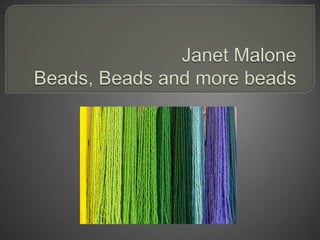Art 507 Powerpoint
- 1. Janet MaloneBeads, Beads and more beads
- 2. Over the years, I have developed a fascination of what my friends call “the tedious.” I take small glass seed beads and glue them to canvases one by one to create a large piece of art. When I first started this technique, I completely covered the canvas in beads, as seen in the following artwork Red Currents. This was very, very time consuming, but also very rewarding when the last bead was glued on. Red Currents took six months to finish.
- 3. Red Currents200522x28Glass Beads
- 4. While I really enjoyed working with only beads and canvas, I found myself working larger and larger, which posed a problem. I was beginning to have problems reaching the middle of the canvas (my arms are short) and the canvas must be lying flat while I work on it (otherwise the beads slide around before the glue dries). I decided to try making smaller pieces that could be glued together to make larger artwork. I used foam core for this purpose because it was light enough not to weigh the canvas down. I was also becoming faster at beading. Inferno took five months to complete, and Rebellion took only four.
- 5. Inferno200722x28Glass Beads, Foam Core, Acrylic Paint
- 6. Inferno was created because an friend was interested if I could use more than just the cool colors in my artwork (I work primarily in the cool colors, with splashes of red or orange for contrast.) I rose to the challenge. Rebellion reverts back to my preferred colors, but is also based on stained glass windows. I love having solid black lines (similar to the lead cane in stained glass windows) “outlining” shapes in my work, and wanted to emphasize this in this piece.
- 7. Rebellion200724x36Glass Beads, Foam Core,Acrylic Paint
- 8. This is when I enrolled in graduate school. I became concerned about having to complete a number of projects in only one semester. It was at this time that I decided to try adding more paint into my artwork. I thought that I could make the painting a more important aspect of my art (previously, the paint had been used as a background color only) and therefore spend less time beading. I based the following artworks off of Dale Chihuly’s Seaforms because of their beautiful colors and organic shapes.
- 9. Fluted Green200815x30Glass Beads, Foam Core, Acrylic Paint
- 10. Orange Organics200820x24Glass Beads, Acrylic Paint
- 11. Earth200918x24Glass Beads, Acrylic Paint
- 12. Golden Edge20088x24Glass Beads, Acrylic Paint
- 13. After the first semester, I realized that while I had a few successful pieces with this idea, I really was not happy with the artwork overall (other than Fluted Green, I love this one). I realized that I spent so much time focusing on the painting, that the beads were almost an afterthought. I was frustrated with the painting as well. I don’t usually paint much, and it has been years since I have completed a painting. I could tell that I was out of practice, and just couldn’t get the paint to do what I wanted. I decided to change my idea for the next semester and revert back to beads with a simple color background to show them off. I chose to work with the four elements- earth, air, fire and water. I wanted to have some depth to my artwork, so there are three layers of foam core for each piece that are placed on top of each other, all of which are adhered to a canvas. I also decided to add some other objects to the pieces, such as shells, buttons and rocks.
- 14. Earth Element200918x18Glass Beads, Foam Core, Rocks, Acrylic Paint
- 15. Fire Element200918x18Glass Beads, Paua Shell, Foam Core, Acrylic Paint
- 16. Air Element200918x18Glass Beads, Foam Core, Acrylic Paint
- 17. Water Element200918x18Glass Beads, Buttons,Foam Core, Acrylic Paint
- 18. While I was researching the elements for these pieces, trying to find any symbols or colors that are associated with the elements, I came across quite a few books and websites that stated the elements were also associated with the cardinal directions. Earth is considered to be north, fire is south, air is east and water is west. While this did not factor into my designs, in fact, I didn’t learn about this until I was almost finished with the first artwork, and they were intended to be four separate pieces, I was interested in possible displaying the pieces together in their cardinal directions. I chose to turn the pieces diagonally (thankfully, the pieces did not have a top, and could be displayed this way.)
- 19. The Four Elements displayed together36x36 (overall)


















